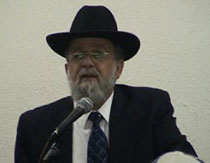Beit Midrash
- Torah Portion and Tanach
- Shmot
- Ki Tisa
saga of the Golden Calf. How can we tie it all together?
Let’s look at the opening & closing of the Parsha. We begin with the census, conducted via the giving of the half-shekel. Over & over, the Torah says this act is a "kofer," referring to the money as "kesef ha-kippurim." The root of the word "kapara," I suggest, means "covering," as in Kaporet, the cover of the Aron Kodesh. This cover protected the Aseret Ha-Dibrot inside the Ark, Judaism’s most precious object. The clear implication is that by giving Tzedaka, particularly for the good of the Tzibur (the half-shekel was used for the Mishkan’s upkeep), we "cover" ourselves with merit & so are shielded from harm.
The other items mentioned in the Sedra also serve as a kapara, a protection for us: Observing Shabbat & Chag; bringing offerings, dedicating our children to the service of Hashem (represented here by the Pidyon Ha-Ben) & prayers
of supplication (i.e. the 13 Midot which Hashem teaches Moshe) all make up the spiritual "flak-jacket" we wear to get us through precarious daily life.
But when we remove that protective vest – if we discard our faith & turn away from Hashem, chas v’shalom – then we enter a mine-field that can prove dangerous, even fatal to our well-being. And that is exactly what happened in the tragic incident of the Egel Ha-Zahav.
When Moshe descends from Mt. Sinai, the pasuk records his reaction: "Moshe saw the nation, & it was paru’ah!" The word "paru’ah" means "uncovered, exposed." The sin of the nation was revealed in living (or dying!) color; they
had shed their protective wear by turning to a false god.
Fast-forward to the very end of the Sedra. After receiving the 2nd set of the Luchot, Moshe comes before the people – wearing a mask! Now, this is definitely NOT in honor of Chag Purim! Chazal say that Moshe's radiant glow, resulting
from coming "into contact" with G-d, scared the people to the point where they could not face him. ANd so he donned a mask, or veil.
But I suggest that Moshe’s mask conveyed a very crucial lesson that Moshe needed to teach – frontally! – to each & every Jew: This world is a tough place in which to survive. Everywhere we turn there is danger: physical, financial,
spiritual. Without Hashem’s constant protection, we expose ourselves to constant, serious threat. But every time we "cover up" with Mitzvot, we safeguard ourselves from harm.
This - then, and now - is the secret to surviving in the "Naked City."

The Oral Law – A Torah of Life
based on Siach Shaul, pg. 294-5
Rabbi Shaul Yisraeli zt"l | Adar 5773

Honor for Whom?
Parashat Ki Tisa
Rabbi Yossef Carmel | 11 Adar 5766





















